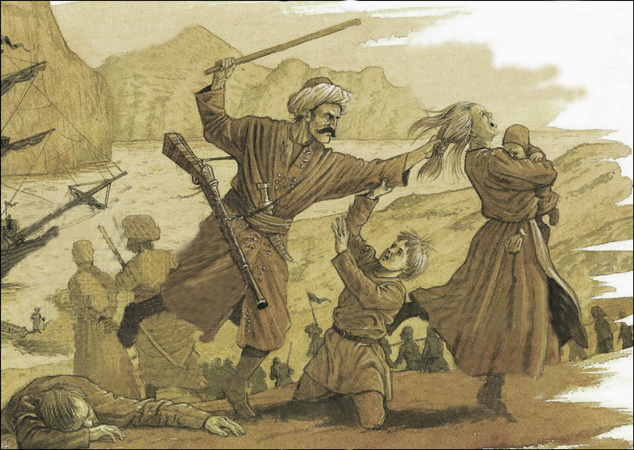(This post is a continuation of The Barbary Corsair Raid on Heimaey in 1627– Parts 1, 2, & 2. If you haven’t done so already, it’s best to read that post before continuing on here.)
This week, we continue with the story of the Barbary corsair attack on the island Heimaey, taken from Stolen Lives, the book my Icelandic colleague, Karl Smári Hreinsson, and I published last year.
In last week’s excerpt, the corsair attack had just begun. This week, we follow how it unfolded.
There were two parishes on Heimaey: Ofanleiti on the west side of the island and Kirkjubær on the east (see the map of the island below). The gang of corsairs beating their way up the west side of the island overran Ofanleiti so suddenly that they took everybody there by surprise. The pastor there was Reverend Ólafur Egilsson. The corsairs quickly captured him, along with two maidservants and a baby who were with him. When he tried to resist, the corsairs beat him with the buts of their spears.
Reverend Ólafur was in his early sixties when the Algerine corsairs attacked and had been serving as pastor in Ofanleiti for over thirty years. His first wife had died, and he remarried a much younger woman, Ásta Þorsteinsdóttir, who was nine months pregnant at the time of the raid.
Though there is no way of knowing for certain, Ofanleiti farmstead likely consisted of several linked sod houses and a small chapel. After they had subdued Reverend Ólafur and the group with him, the corsairs searched the sod houses, even going so far as to light torches to peer into root cellars and attic crawl spaces. They found an old woman clinging desperately atop of a pile of firewood, attempting to hide. Hauling her roughly down, they threw her onto the sod in front of the main farmhouse, where she lay, rigid with terror.
At this point, the eleven-year-old son of Reverend Ólafur showed up. Heimaey must have been an idyllic place for a boy back in those days: no institutionalized school to attend, and an entire island over which he could roam freely. The Icelandic text says he “came by, all unsuspecting, to see his parents,” the implication being that he had been out gallivanting about the island and had come back unaware that the raid was in progress.
Whatever the case, he was snatched by the corsairs the instant he appeared. They tied him up and dumped him on the sod next to the old woman they had dragged from the woodpile. Then they went off in search of more captives. Reverend Ólafur’s son begged the old woman to untie him so he could run off, but she was too terrified and only lay there, shaking. On such a small thing did this boy’s life turn. If the old woman had freed him, he might have fled, escaping capture entirely, and lived out the rest of his days peaceably in Iceland. That was not, however, how his life unfolded.
The corsairs soon returned, having rounded up a couple more children and a number of adults. Having thoroughly searched all the farm buildings, they now set fire to them. Among the captives they had taken was a crippled woman who could not walk, whom they had easily caught. One of the Icelandic texts records what happened to her:
“Her they threw on the fire, along with her two-year- old baby. When she and
the poor child screamed and called to God for help, the wicked Turks bellowed
with laughter. They stuck both child and mother with the sharp points of their
spears, forcing them into the fire, and even stabbed fiercely at the poor, burning bodies.”
After this, the corsairs gathered all their captives together and herded them northwards towards the harbor.
Their route took them past Fiskhellar (“Fish Caves” in Icelandic) (see the map of the island above). To prevent flies from getting at them, the islanders stored stacks of harðfiskur (air-dried fish) in caves embedded in the upper part of a tall, slanting cliffside there—hence the name. Seeing the rampaging corsair band coming, the islanders in the area had scrambled up the cliff face and into the caves to hide. The corsairs spotted them, though, and followed after, dragging people back down one by one. Those they could not reach, they shot at with their muskets. Some of those whom they hit fell tumbling from the cliff face to smash upon the rocks below. Others stayed where they were, braced in a cave mouth of propped on a ledge, “looking as though they were alive.”
Once they had amassed all the captives they could at the cliff, the corsairs gathered everybody together and drove them onwards to the harbor.
For more on the Barbary corsair attack on the island of Heimaey, see the next post n this series here in this blog.

Corsairs and Captives
Narratives from the Age of the Barbary Pirates
View Amazon listing
The Travels of Reverend Ólafur Egilsson
The story of the Barbary corsair raid on Iceland in 1627
View Amazon listing
